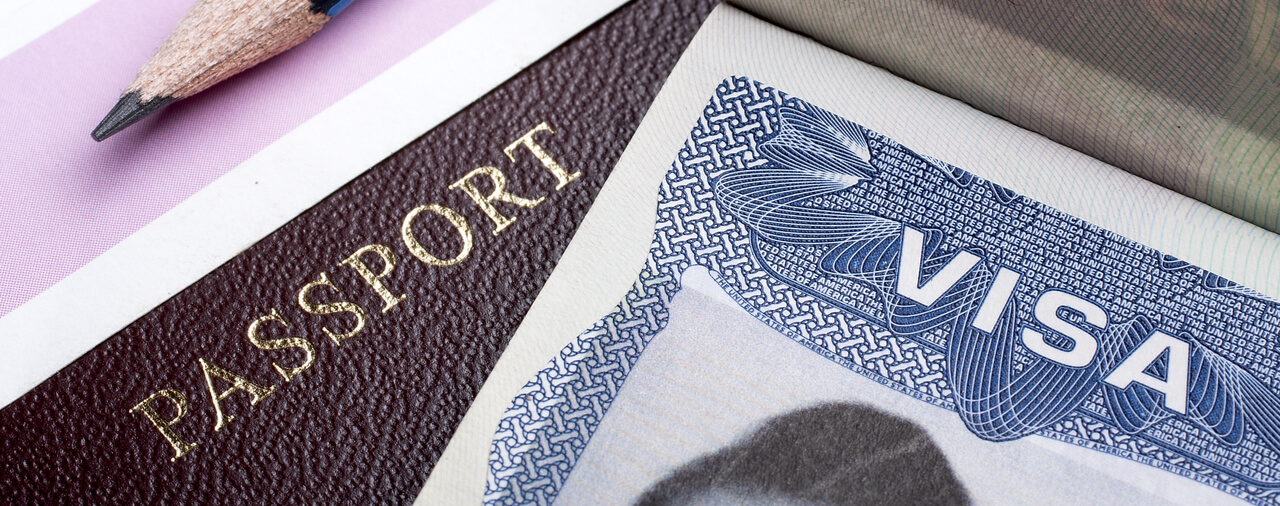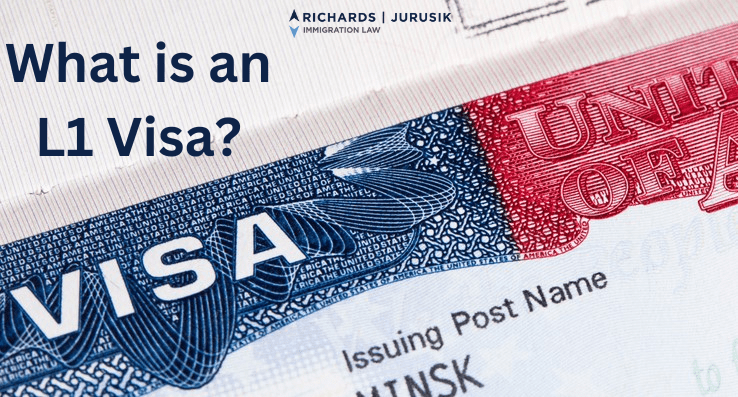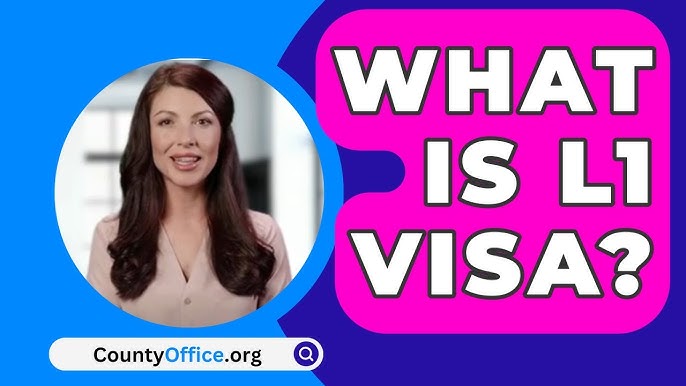Unlocking Opportunities: A Comprehensive Guide to the L1 Visa Process
The L1 visa procedure provides an important pathway for international companies seeking to transfer essential workers across boundaries. Understanding the subtleties of eligibility standards, the distinctions between L-1A and L-1B visas, and the intricacies of the application procedure can substantially affect a candidate's success. Steering this complicated landscape is not without its difficulties, and mindful attention to documents and company sponsorship is necessary. As we check out the crucial elements of this process, the techniques for overcoming possible barriers will end up being noticeable, revealing just how notified prep work can open a world of chances.
Understanding the L1 Visa
Recognizing the L1 visa entails identifying its significance as an essential device for international firms looking for to transfer competent staff members in between international offices. This non-immigrant visa category assists in the movement of execs, supervisors, and specialized understanding workers to the USA, thereby enabling companies to preserve operational continuity and harness global skill successfully. The L1 visa is separated into two primary categories: L-1A for managers and executives, and L-1B for employees having specialized knowledge.The L1 visa offers a crucial duty in boosting a firm's one-upmanship in the international marketplace - L1 Visa Requirements. By permitting business to move their crucial employees, companies can assure that essential projects are taken care of by certified individuals who are already knowledgeable about the firm's culture and operational processes. This interior transfer system not just cultivates expertise sharing yet additionally promotes advancement and partnership across borders.Moreover, the L1 visa is typically preferred for its reasonably simple application procedure contrasted to various other visa groups, as it permits for twin intent, permitting owners to pursue irreversible residency while on a momentary copyright. This attribute makes the L1 visa specifically appealing for both employers and staff members, as it enhances the path for competent experts to develop long-term residency in the United States
Qualification Standards
Eligibility for the L1 visa hinges on a number of crucial criteria that ensure both the staff member and the company satisfy specific qualifications. This non-immigrant visa is created for international firms to transfer employees from international workplaces to united state counterparts.Firstly, the company should be a qualifying company, that includes a parent company, branch, affiliate, or subsidiary of an U.S. business. The firm should have been doing service for at the very least one year both in the united state and abroad. This ensures that the firm has adequate operational stability and a legit presence.Secondly, the employee has to hold a supervisory, executive, or specialized expertise position. For L1A visas, the candidate should show supervisory or executive credentials, while L1B visas focus on specialized expertise pertaining to the company's products, solutions, or procedures. In addition, the worker needs to have benefited the international entity for at the very least one continual year within the last 3 years prior to their application.Lastly, the staff member's function in the U.S. have to line up with their previous position, guaranteeing that their skills and proficiency are leveraged for the business's benefit.
Sorts Of L1 Visas
The L1 visa classification comprises 2 primary types created to help with the transfer of employees within multinational firms: the L1A visa for supervisors and execs, and the L1B visa for workers with specialized expertise. Each type serves unique purposes and has certain eligibility criteria.The L1A visa is customized for people that hold managerial or executive placements within a company. This visa enables high-level staff members to move to a united state branch, subsidiary, or affiliate of the same company. Applicants for the L1A visa must show that they have actually been utilized in a managerial or executive capability for a minimum of one continuous year within the past three years before their application. In addition, this visa supplies a much longer duration of stay, initially approved for 3 years, with the possibility of extensions for as much as seven years.In comparison, the L1B visa is planned for professionals with specialized expertise pertaining to the business's products, services, or procedures. To certify, applicants need to prove that their proficiency is critical to the organization and that they have actually benefited a minimum of one continual year within the last three years in a role that required this specialized knowledge. The L1B visa is at first approved for three years, with extensions available for up to 5 years.Both visa types are essential for business seeking to boost their international procedures by leveraging proficient employees, consequently promoting technology and performance within the united state market.
Application Process
Steering with the L1 copyright procedure entails several important steps that need to be thoroughly followed to assure a successful end result. The process begins with the united state company, that have to initially establish eligibility by showing a certifying relationship with the foreign entity and validating that the employee meets the details requirements for the L1 visa group being sought.Once qualification is verified, the company initiates the procedure by submitting Form I-129, the Petition for a Nonimmigrant Employee, with the United State Citizenship and Immigration Solutions (USCIS) This form must be come with by a detailed summary of the task duties to be performed, the business framework of both the U.S. and foreign entities, and the employee's credentials. It's important to validate that all details is exact and complete, as noninclusions or mistakes can bring about hold-ups or denials.Upon authorization of the I-129 application, the next action involves the employee requesting the L1 visa at a united state consular office or consular office in their home nation. This stage needs the conclusion of Type DS-160, the Online Nonimmigrant copyright, and setting up an interview. During the meeting, the applicant must provide proof supporting their certifications and the company's petition.After the visa is provided, the worker can get in the USA to function in the designated duty. Generally, mindful prep work and adherence to every step of the application process are necessary for a successful L1 visa end result.
Called for Paperwork

Essential Types Needed
Navigating the L1 Visa procedure calls for careful attention to the essential kinds and documents required for a successful application. The key form needed is the Kind I-129, Application for a Nonimmigrant Worker, which should be finished and submitted by the U.S. company. This form details the information of the work offer and the qualifications of the worker looking for the L1 Visa.Alongside Kind I-129, the applicant will certainly need to full Form I-539 if going along with member of the family are also requesting visas. In addition, the company should provide proof of the qualifying connection between the united state entity and the foreign entity, frequently requiring the submission of corporate documents such as short articles of incorporation or financial statements.Moreover, it is crucial to consist of the L Category Supplement to Kind I-129, which defines the type of L Visa being requested-- either L-1A for managers and executives or L-1B for employees with specialized knowledge. Applicants ought to ensure that all types are signed and dated appropriately, as insufficient submissions can lead to delays or rejections. Correctly putting together these crucial forms lays the foundation for a smoother L1 copyright procedure.

Sustaining Evidence Needs
Sustaining documentation is necessary for an effective L1 copyright, as it corroborates the claims made in the request. Candidates need to provide a range of files to show qualification for the visa, which is categorized right into two primary types: proof of the qualifying partnership between the united state and foreign entities and evidence of the applicant's qualifications.To establish the partnership, candidates should submit documents such as corporate organizational charts, financial statements, and evidence of possession. These papers confirm that the international company has a certifying connection with the U.S. company, whether as a moms and dad firm, subsidiary, branch, or affiliate.For the applicant's qualifications, crucial documents include an in-depth work letter from the international employer, detailing the candidate's job title, responsibilities, and period of employment. Furthermore, instructional credentials, such as levels and diplomas, should be offered to confirm the candidate's knowledge in the pertinent area.
Employer Sponsorship Papers

Typical Obstacles
Maneuvering the L1 visa process offers numerous common obstacles that applicants need to understand. Secret concerns commonly consist of strict documentation requirements, potential hold-ups in handling times, and the need for rigorous legal compliance. Understanding these obstacles can assist candidates much better prepare and minimize risks during their copyright trip.
Documentation Requirements
The L1 copyright procedure frequently presents considerable difficulties connected to documents needs. Applicants need to supply comprehensive documents to develop qualification, which can cause complication and potential delays. Secret files consist of proof of a certifying relationship in between the united state and international company, evidence of the candidate's work background, and comprehensive info about the work role in the U.S.One typical obstacle is gathering enough evidence to show the nature of the certifying connection. Companies usually battle to present clear organizational graphes or economic statements that show the link between the entities. Furthermore, ensuring that letters of assistance from employers accurately show the candidate's job tasks and qualifications is necessary, as vague summaries can cause denials.Another issue emerges from the requirement for comprehensive task descriptions that align with the L1 visa groups. Candidates need to verbalize not only their current duty however likewise their supervisory or specialized expertise duties plainly. This necessitates an extensive understanding of both the applicant's position and the L1 Visa regulatory language used in L1 applications.
Processing Time Delays
Experiencing delays in handling times is an usual difficulty encountered by L1 visa candidates, typically leading to disappointment and unpredictability. Numerous aspects contribute to these delays, including high application volumes, raised scrutiny of applications, and management stockpiles within the united state Citizenship and Immigration Services (USCIS) Applicants might discover that processing times can differ greatly depending upon the service center managing their application, as each center has its very own workload and performance degrees. In addition, the intricacy of the applicant's instance, such as the requirement for extensive documents or clarification, can additionally expand wait times.In some circumstances, concerns related to the candidate's present immigration status or previous visa history might additionally bring about extra delays, as USCIS might call for additional review or info. It is important for prospects to continue to be aggressive throughout this duration, keeping open interaction with their companies and lawful representatives to address any kind of potential concerns promptly.Understanding these handling time difficulties can assist L1 visa candidates prepare for possible delays and mitigate the impact on their shift and career plans. Patience and persistance are essential merits in maneuvering this elaborate process.
Lawful Conformity Issues
Many L1 visa candidates run into lawful compliance problems that can complicate their trip toward getting the visa. Comprehending and sticking to the specific guidelines set by the U.S. Citizenship and Immigration Services (USCIS) is important. Common difficulties include demonstrating the qualifying relationship between the international and united state employers, in addition to proving that the applicant possesses the requisite customized expertise or supervisory capacity.Additionally, applicants have to offer complete documentation detailing their task duties, business framework, and economic viability of the U.S. entity. Insufficient or imprecise documentation can lead to hold-ups or perhaps denials. Employers have to additionally assure that they follow labor regulations, including wage and working problem criteria, which can affect visa eligibility.Another usual issue entails keeping compliance with the terms of the visa once given. Adjustments in work status, job obligations, or firm structure can necessitate changes to the visa, which if not addressed immediately can result in legal complications. Therefore, remaining educated about conformity requirements and looking for legal advice when necessary is vital to browse the intricacies of the L1 visa procedure efficiently.
Tips for Success
Success in the L1 copyright process usually hinges on careful preparation and focus to detail. To boost your chances of authorization, start by completely understanding the eligibility demands for both the L1A and L1B visa groups. Review whether your placement at the firm certifies as supervisory, executive, or specialized knowledge, as this categorization significantly influences your application.Next, collect considerable paperwork that corroborates your cases. This includes organizational charts, detailed task descriptions, and proof of the business's operational framework. Clear and concise evidence of the certifying relationship in between the U.S. entity and the foreign entity is essential. Verify that all records are organized practically and provided in a specialist way, as this shows your dedication and seriousness regarding the application.Engage the services of a seasoned immigration lawyer who focuses on L1 visas. Their experience can confirm indispensable, guiding you with complicated guidelines and assuring that all documentation abides by present regulations. Additionally, get ready for the meeting by practicing solution to common inquiries and being prepared to review your role and contributions to the business extensive.
Frequently Asked Questions
Can Family Members Members Go Along With the L1 Visa Holder?
Yes, relative of L1 visa holders, consisting of partners and single children under 21, can come with the primary visa holder. They might also apply for L2 visas, which allow them to reside in the United States.
How Lengthy Can I Remain on an L1 Visa?
The L1 visa allows initial stays of up to 3 years, with the opportunity of expansion. L1A visa holders may stay for an optimum of 7 years, while L1B visa owners can continue to be for 5 years.
Can L1 Visa Owners Apply for a Permit?
Yes, L1 visa owners can look for a permit. L1 Visa. They may seek permanent residency with employment-based classifications, usually requiring sponsorship from their employer, offered they fulfill the needed certifications and documentation requirements
What Occurs if My L1 copyright Is Refuted?
If your L1 copyright is refuted, you might receive a notice outlining the reasons for denial. You can seek to appeal the choice, reapply, or check out alternate visa alternatives based upon your scenarios.
Exist Any Type Of Traveling Restrictions With an L1 Visa?
An L1 visa generally permits worldwide traveling; however, re-entry to the united state rests upon preserving valid status. Travelers must assure conformity with visa conditions to stay clear of problems upon return
Verdict
